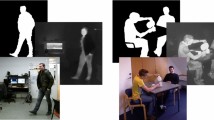Abstract
Foreground blobs in a mixed stereo pair of videos (visible and infrared sensors) allow a coarse evaluation of the distances between each blob and the uncalibrated cameras. The main goals of this work are to find common feature points in each type of image and to create pairs of corresponding points in order to obtain coarse positionning of blobs in space. Feature points are found by two methods: the skeleton and the Discrete Curve Evolution (DCE) algorithm. For each method, a feature-based algorithm creates the pairs of points. Blob pairing can help to create those pairs of points. Finally, a RANSAC algorithm filters all pairs of points in order to respect the epipolar geometrical constraints. The median horizontal disparities for each pair of blobs are evaluated with two different ground truths. In most cases, the nearest blob is detected and disparities are as accurate as the background subtraction allows.
Preview
Unable to display preview. Download preview PDF.
Similar content being viewed by others
References
Hajebi, K., Zelek, J.S.: Sparse disparity map from uncalibrated infrared stereo images. In: CRV 2006. Proceedings of the 3rd Canadian Conference on Computer and Robot Vision, pp. 17–17 (2006)
Jones, G.D., Hodgetts, M.A., Allsop, R.E., Sumpter, N., Vicencio-Silva, M.A.: A novel approach for surveillance using visual and thermal images, 9/1–919 (2001)
Ju, H., Bhanu, B.: Detecting moving humans using color and infrared video. In: MFI 2003. Multisensor Fusion and Integration for Intelligent Systems, pp. 228–233 (2003)
Zitnick, C.L., Kanade, T.: A cooperative algorithm for stereo matching and occlusion detection. IEEE Transactions on Pattern Analysis and Machine Intelligence 22(7), 675–684 (2000)
Hajebi, K., Zelek, J.S.: Dense surface from infrared stereo. In: WACV 2007. Workshop on Applications of Computer Vision, pp. 21–21 (2007)
Kovesi, P.: Phase congruency: A low-level image invariant. Psychological Research 64(2), 136–148 (2000)
Shah, S., Aggarwal, J.K., Eledath, J., Ghosh, J.: Multisensor integration for scene classification: an experiment in human form detection, vol. 2, pp. 199–202 (1997)
Shoushtarian, B., Bez, H.E.: A practical adaptive approach for dynamic background subtraction using an invariant colour model and object tracking. Pattern Recognition Letters 26(1), 5–26 (2005)
Douglas, D.H., Peucker, T.K.: Algorithms for the reduction of the number of points required to represent a digitized line or its caricature. Cartographica: The International Journal for Geographic Information and Geovisualization 10(2), 112–122 (1973)
Borgefors, G.: Distance transformations in digital images. Computer Vision, Graphics, and Image Processing 34(3), 344–371 (1986)
Cheriton, D., Tarjan, R.E.: Finding minimum spanning trees. SIAM Journal on Computing 5(4), 724–742 (1976)
Latecki, L.J., Lakamper, R.: Polygon Evolution by Vertex Deletion. In: Nielsen, M., Johansen, P., Olsen, O.F., Weickert, J. (eds.) Scale-Space Theories in Computer Vision. LNCS, vol. 1682, Springer, Heidelberg (1999)
Fischler, M.A., Bolles, R.C.: Random sample consensus: a paradigm for model fitting with applications to image analysis and automated cartography. Commun. ACM 24(6), 381–395 (1981)
Author information
Authors and Affiliations
Editor information
Rights and permissions
Copyright information
© 2007 Springer-Verlag Berlin Heidelberg
About this paper
Cite this paper
St-Onge, PL., Bilodeau, GA. (2007). Visible and Infrared Sensors Fusion by Matching Feature Points of Foreground Blobs. In: Bebis, G., et al. Advances in Visual Computing. ISVC 2007. Lecture Notes in Computer Science, vol 4842. Springer, Berlin, Heidelberg. https://doi.org/10.1007/978-3-540-76856-2_1
Download citation
DOI: https://doi.org/10.1007/978-3-540-76856-2_1
Publisher Name: Springer, Berlin, Heidelberg
Print ISBN: 978-3-540-76855-5
Online ISBN: 978-3-540-76856-2
eBook Packages: Computer ScienceComputer Science (R0)




